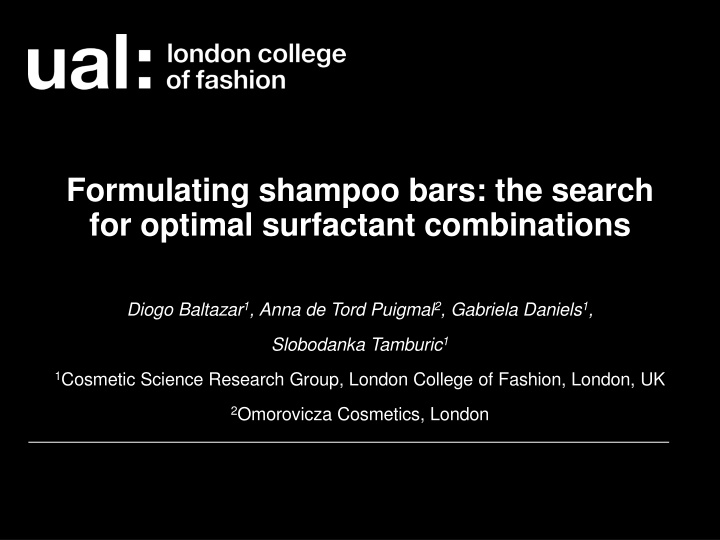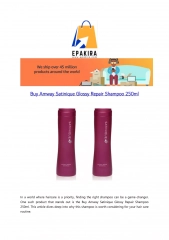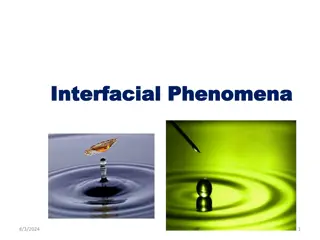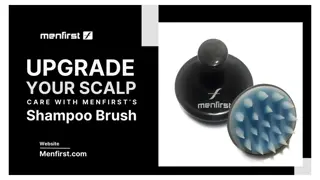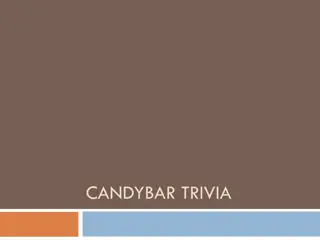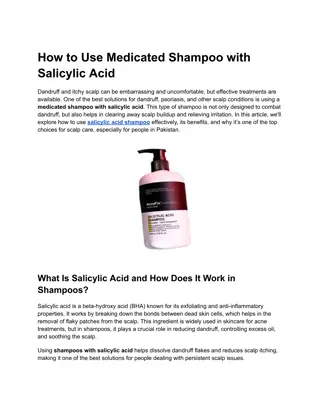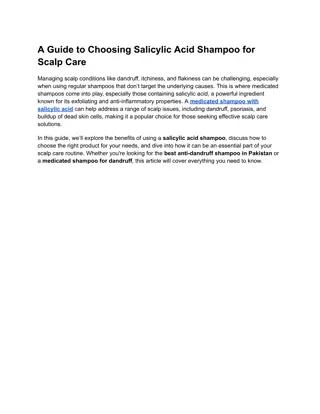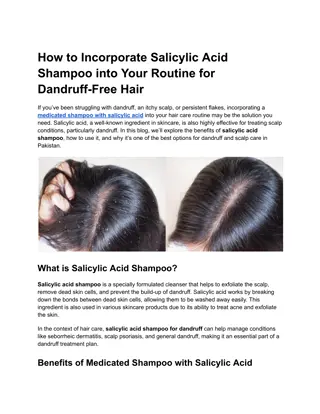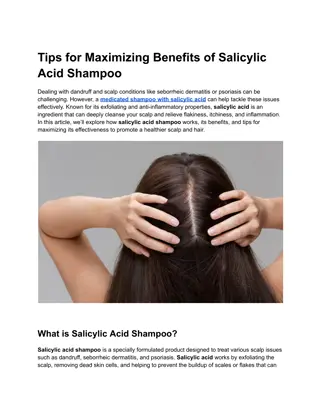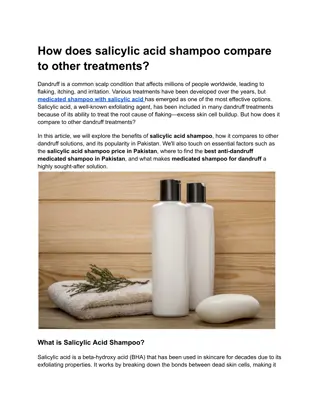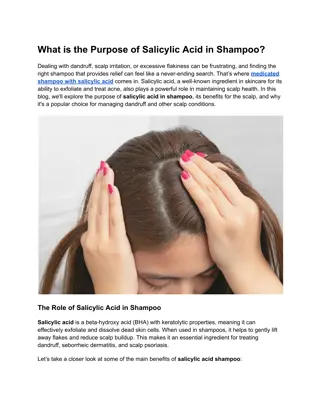Optimizing Shampoo Bars: Surfactant Combinations Study
Shampoo bars offer a sustainable alternative to liquid shampoos, but research into their optimization is lacking. This project aims to test various solid surfactant combinations to develop stable shampoo bars that meet consumer demands. The study includes formulation details, stability testing methods, bar dissolution, and Zein Protein Irritancy Test results to ensure product quality.
Download Presentation

Please find below an Image/Link to download the presentation.
The content on the website is provided AS IS for your information and personal use only. It may not be sold, licensed, or shared on other websites without obtaining consent from the author.If you encounter any issues during the download, it is possible that the publisher has removed the file from their server.
You are allowed to download the files provided on this website for personal or commercial use, subject to the condition that they are used lawfully. All files are the property of their respective owners.
The content on the website is provided AS IS for your information and personal use only. It may not be sold, licensed, or shared on other websites without obtaining consent from the author.
E N D
Presentation Transcript
Formulating shampoo bars: the search for optimal surfactant combinations Diogo Baltazar1, Anna de Tord Puigmal2, Gabriela Daniels1, Slobodanka Tamburic1 1Cosmetic Science Research Group, London College of Fashion, London, UK 2Omorovicza Cosmetics, London
Introduction and Aim Shampoo bars present a sustainable alternative to liquid shampoos due to minimal use of water and the reduction of the product s volume and weight; Shampoo bars must be consistent in performance and stability; Increasing demand for shampoo bars is not matched by research into their optimisation. Aim of this project: To test a series of solid surfactant combinations and their ability to provide stable shampoo bars that meet consumer demands.
Materials Base formulation ingredients: Stearyl Alcohol Methylparaben (and) Ethylparaben (and) Propylparaben Surfactants Disodium Lauryl Sulfosuccinate (DLS) Sodium Coco-Sulfate (SCS) Cocamidopropyl Betaine (CAPB) Cocamide MEA (CMEA)
Methods: formulation 1. Phase B heated to 70 C; 2. Phase A coated with the Phase B solution; 3. Cooling down to RT; 4. Pressing at ~50 psi. Table 1. Shampoo Bars formulation overview INCI % (w/w) Phase Disodium Lauryl Sulfosuccinate (DLS) 0 77.30 A Sodium Coco-Sulfate (SCS) 0 77.30 Cocamidopropyl Betaine (CAPB) 0 77.30 Cocamide MEA (CMEA) 0 25.00 B Stearyl Alcohol 22.50 Methylparaben (and) Ethylparaben (and) Propylparaben 0.02
Methods Stability testing 12 weeks: at 4 C; at RT, both exposed to sunlight & protected from sunlight Accelerated: at 40 C. pH bars dissolved to obtain 0.03% solution at RT; 3505 pH meter (Jenway, UK). Hardness P/2N 2 mm probe, average hardness (g) with a TA.XTplus Texture Analyser (Stable Micro Systems, UK) using the Exponent software. Foam bars dissolved to obtain 0.03% solution at RT; 50 mL of solution shaken 10x (Foam Volume calculated) and left to drain for 1, 2, 3, 4 and 5 min (Foam Drainage calculated).
Methods Bar dissolution: time required to dissolve fully a bar sample to obtain a 0.03% solution under stirring, up to 8 h; Bar cracking: bars in contact with deionised water on one side for 2 h and allowed to dry at RT for 24 h; bars assessed against a Standard Cracking Test Rating Scale. Zein Protein Irritancy Test: According to EC s Protocol 26 for Skin Irritation and Corrosivity and following the G tte Modified Method, using a 0.25% shampoo bar solution; BCA Protein Assay, following Pierce TM BCA Protein Assay Kit instructions; absorbance measured at 562 nm. Fig. 1 The Standard Cracking Test Rating Scale (adapted)
Results Stability testing Shampoo bars without CMEA retained their organoleptic properties at RT and 40 C, but some bars presented slight changes at 4 C, potentially due to increased humidity; Shampoo bars with CMEA presented slight or significant changes after 12 weeks at 40 C, but no alterations at 4 C; CMEA could be important in maintaining product properties under humid conditions. o pH of all shampoo bars did not vary throughout the 12 weeks of testing, at all conditions used; pH between 5.0 and 7.0 was observed. o A Period After Opening test should be done to confirm these results.
Results Hardness No major patterns were noticed, but CAPB seems to decrease hardness; CMEA both increased and decreased hardness, but seemed to contribute to bar homogeneity, as the hardness graphs (not shown) showed less fluctuations. Table 2. Average hardness (g) of shampoo bars with and without CMEA Hardness (g) of Bars without CMEA DLS 5.32 SCS 5.40 DLS+CAPB 5.02 SCS+CAPB 4.95 DLS+SCS 5.45 DLS+SCS+CAPB 5.32 CAPB - Hardness (g) of Bars with CMEA 5.54 Surfactant Mixtures 4.84 3.65 5.79 5.53 4.51 4.62
Results Foaming Combining CAPB with anionic surfactants (DLS and SCS) has yielded more foam, i.e. higher foam volume; Binary surfactant mixtures (anionic + amphoteric) appear to work best, compared to other mixtures. o Differences in foam drainage were not observed. Table 3. Foaming power of shampoo bars with and without CMEA VF (mL) for Bars without CMEA VF (mL) for Bars with CMEA Surfactant Mixtures DLS SCS 17.33 15.33 25.33 22.00 8.00 18.67 - 13.33 11.67 25.00 9.67 14.67 15.67 23.67 DLS+CAPB SCS+CAPB DLS+SCS DLS+SCS+CAPB CAPB
Results Bar Dissolution and Cracking DLS consistently showed very long dissolution times, only lowered by combining with CABP; SCS was the quickest to dissolve, but combining it with any other surfactant increased dissolution time; CMEA decreased dissolution time of bars with DLS, but increased those with SCS. All shampoo bars presented cracking between 1 and 2. Table 4. Average dissolution time for shampoo bars in deionised water, to obtain a 0.03% solution Average dissolution time (h) for Bars without CMEA > 8 1 2.5 1.25 > 8 > 8 - Average dissolution time (h) for Bars with CMEA 2.25 2.5 1.25 2.75 3 1.25 > 8 Surfactant Mixtures DLS SCS DLS+CAPB SCS+CAPB DLS+SCS DLS+SCS+CAPB CAPB
Results Zein Protein Irritancy Test DLS consistently showed low irritation potential, especially when used alone or with CMEA, and also reduced the irritation of SCS, even more than CAPB; CAPB + CMEA showed the least irritation potential; 3,0 2,5 2,0 1,5 CMEA appears to reduce irritation potential, overall. 1,0 0,5 0,0 DLS+SCS+CAPB+CMEA DLS+CAPB SCS+CAPB DLS+CMEA DLS+SCS+CAPB SCS+CAPB+CMEA SCS+CMEA CAPB+CMEA DLS+SCS+CMEA DLS SCS DLS+CAPB+CMEA DLS+SCS Fig. 2 The irritation potential of shampoo bars as measured by the amount of zein protein denatured by the surfactants used
Conclusions Optimising shampoo bars for stability and functionality is not a straightforward process surfactants behave differently; Optimising one attribute compromised another. o CAPB appeared to be useful in increasing foaming and mildness; CMEA appeared to influence stability and efficacy; however, this depends on the primary surfactant used; This study should be furthered by using other surfactants and performing instrumental and sensory evaluations in vivo. DLS provided the best properties overall, especially if combined with CAPB, thus being an important surfactant in the creation of stable shampoo bars with good properties for the consumer. Combinations of 2 and 3 surfactants showed better properties than using only 1 or combining 4.
References A. Ogle, Nat Geo (2018). https://www.nationalgeographic.co.uk/environment/2018/08/5-reasons-ditch-your- shampoo-bottle-shampoo-bar (accessed 2020.07.20) The Dow Chemical Company (2015) https://msdssearch.dow.com/PublishedLiteratureDOWCOM/dh_092d/0901b8038 092d6b0.pdf?filepath=personalcare/pdfs/noreg/324-00519.pdf (accessed 2020.07.20) European Commission (2015) http://ec.europa.eu/health/scientific_committees/consumer_safety/docs/sccs_o_1 90.pdf (accessed 2020.07.20) P. A. Cornwell, Int J Cosmet Sci, 40(1), 16-30 (2018) M. B. Morrison, M. Paye, J Soc Cosmet Chem, 46, 291-299 (1995)
